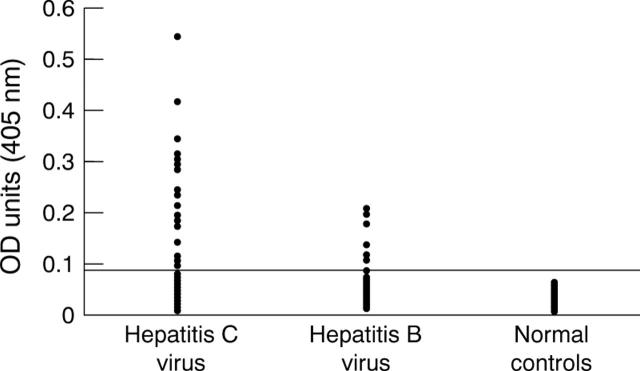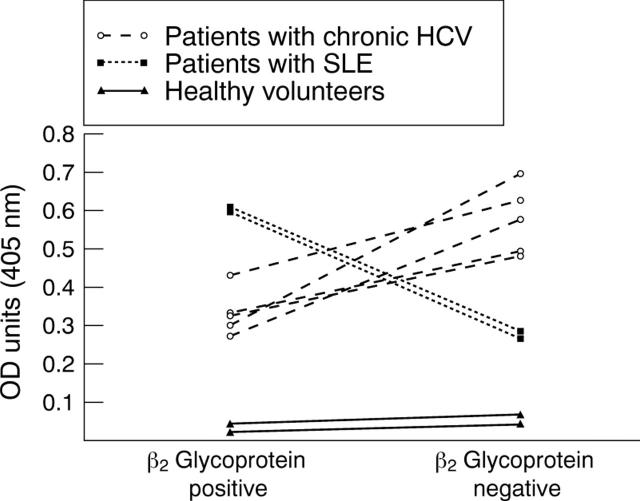Abstract
OBJECTIVE—Chronic hepatitis C virus (HCV) has been linked to extrahepatic autoimmune phenomena. In addition, a variety of autoantibodies are found in patients with HCV. The prevalence, nature, and clinical significance of anticardiolipin (aCL) autoantibodies in serum samples of patients with HCV were therefore investigated. PATIENTS AND METHODS—A prospective study of 48 consecutive patients with chronic HCV with no evidence of previous hepatitis B virus (HBV) infection or any other autoimmune disorder. Thirty patients with HBV and 50 healthy volunteers matched for age and sex served as control groups. Anticardiolipin antibodies in the serum samples and cryoprecipitates were measured by a sensitive enzyme linked immunosorbent assay (ELISA). The β2 glycoprotein I (β2-GPI) dependency was determined by carrying out aCL assays in the presence or absence of fetal calf serum samples. RESULTS—High levels of IgG aCL antibodies were detected in serum samples of 21/48 (44%) patients with HCV. These autoantibodies showed no β2-GPI dependency. The control groups had much lower levels of aCL antibodies (20% in the patients with HBV and none in the normal volunteers). Cryoprecipitates from four patients with HCV (three aCL positive; one aCL negative) were further isolated. In two of the three aCL positive patients, specific cardiolipin reactivity was shown in the cryoprecipitates. The group of patients with HCV and aCL antibodies in their serum showed significantly higher total IgG levels, a higher incidence of antinuclear antibodies, and viraemia (HCV RNA) than the aCL negative patients. None of the patients with HCV and aCL antibodies showed any clinical manifestations related to those autoantibodies. CONCLUSIONS—This study clearly shows a high prevalence of IgG aCL antibodies in the serum of patients with HCV and the localisation of these antibodies in some cryoprecipitates. The role of these autoantibodies on the course of HCV infection and their clinical significance has not yet been determined.
Full Text
The Full Text of this article is available as a PDF (144.2 KB).
Figure 1 .
IgG aCL antibodies in 48 patients with hepatitis C virus (HCV), 30 with hepatitis B virus (HBV), and 50 normal volunteers matched for age and sex. Results represent OD units at 405 nm. Background values representing non-specific binding with "no-antigen" wells were subtracted in all assays. The upper level of normal (line) was defined as mean +3SD over normal controls (mean (SD) OD of controls 0.030 (0.019)).
Figure 2 .
β2 Glycoprotein 1 (β2-GPI) dependency of aCL antibodies in serum samples obtained from patients with hepatitis C virus (HCV) and systemic lupus erythematosus (SLE). Five serum samples obtained from patients with chronic HCV, two patients with SLE and two healthy volunteers were tested, concomitantly, for cardiolipin reactivity in the presence (10% fetal calf serum (FCS)) or absence (1% bovine serum albumin (BSA); no FCS throughout the assay) of β2-GPI. All serum samples were tested in triplicate at a dilution of 1:100. Results represent mean OD units at 405 nm. Background values representing non-specific binding to "no-antigen" wells (blocked with 10% FCS or 1% BSA, respectively) were subtracted in all assays. The standard deviation between triplicates was <10% in all assays.




